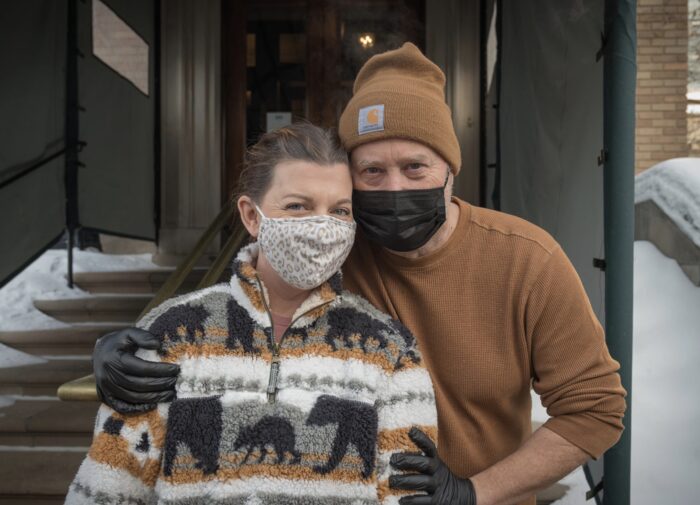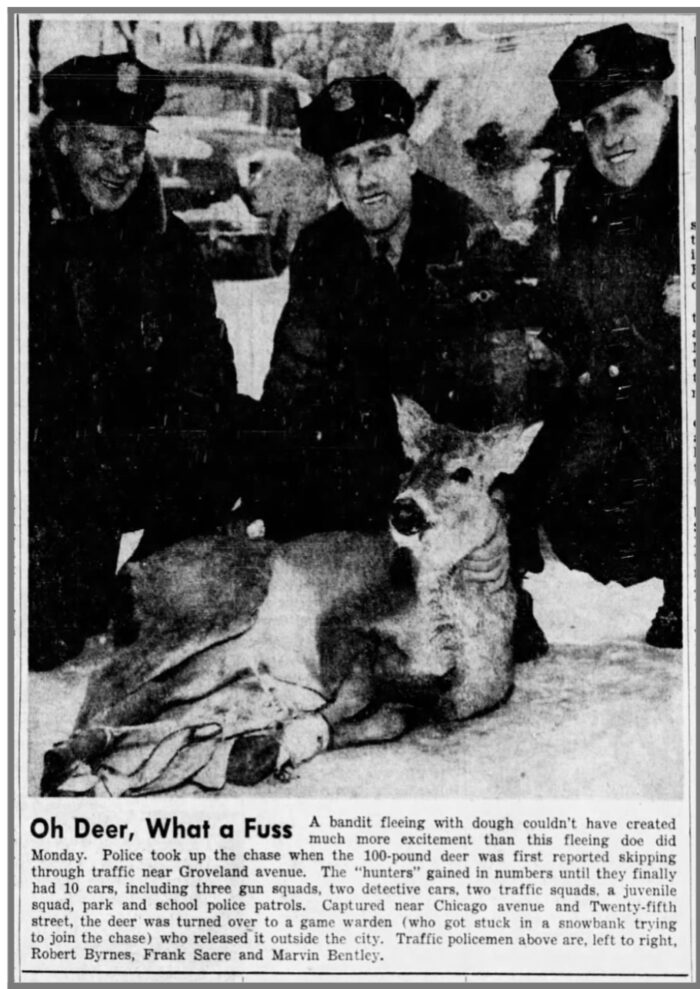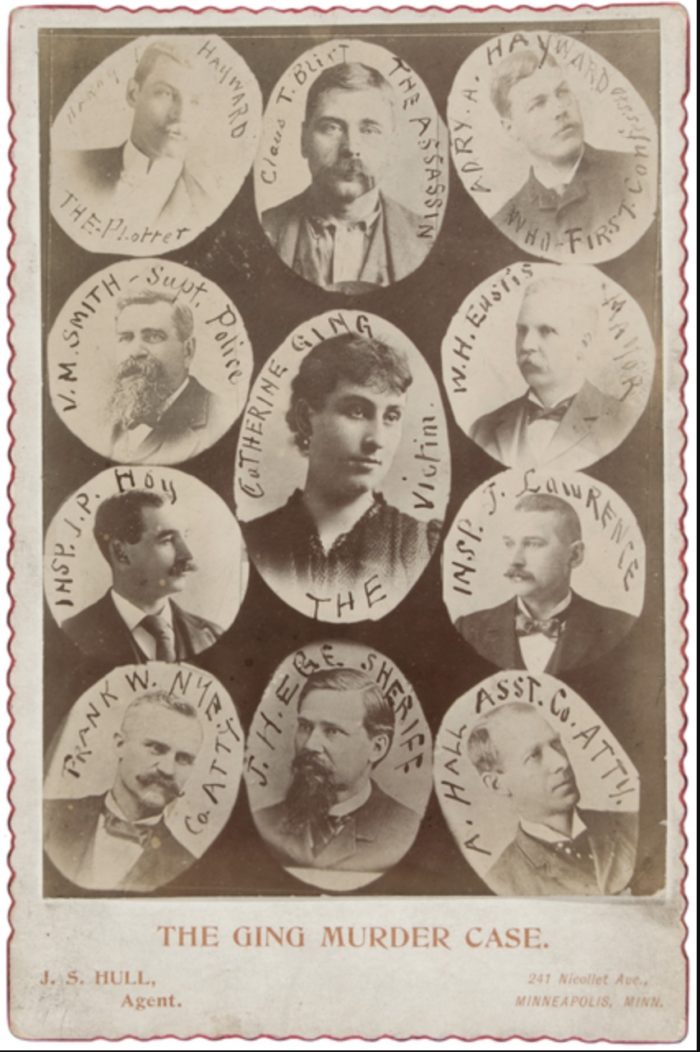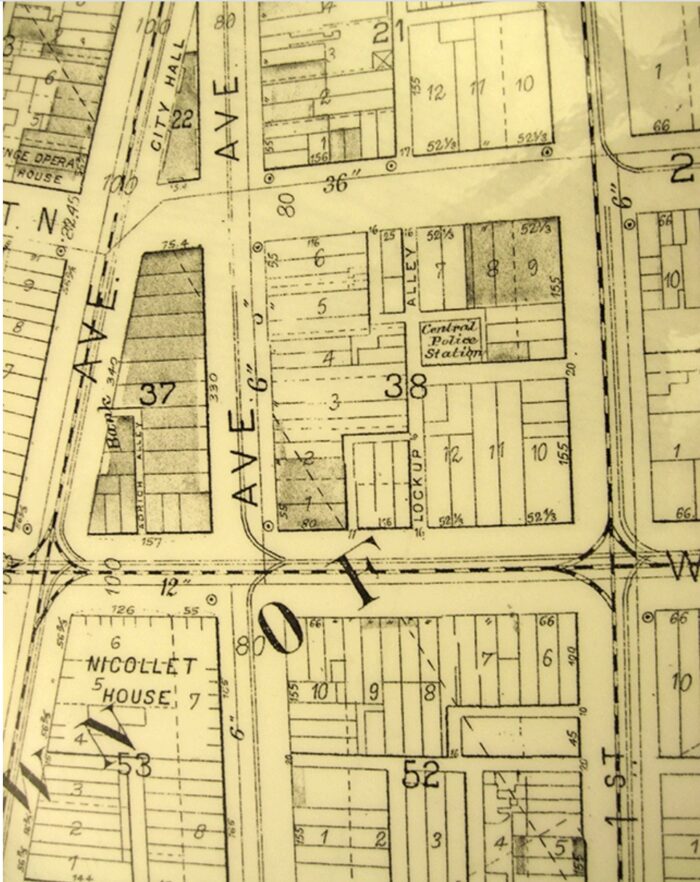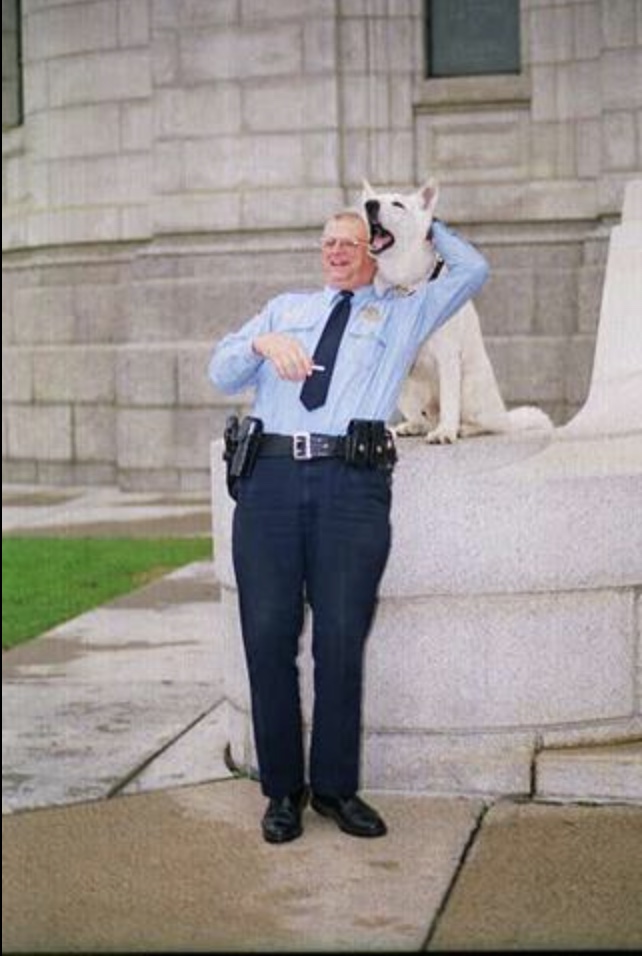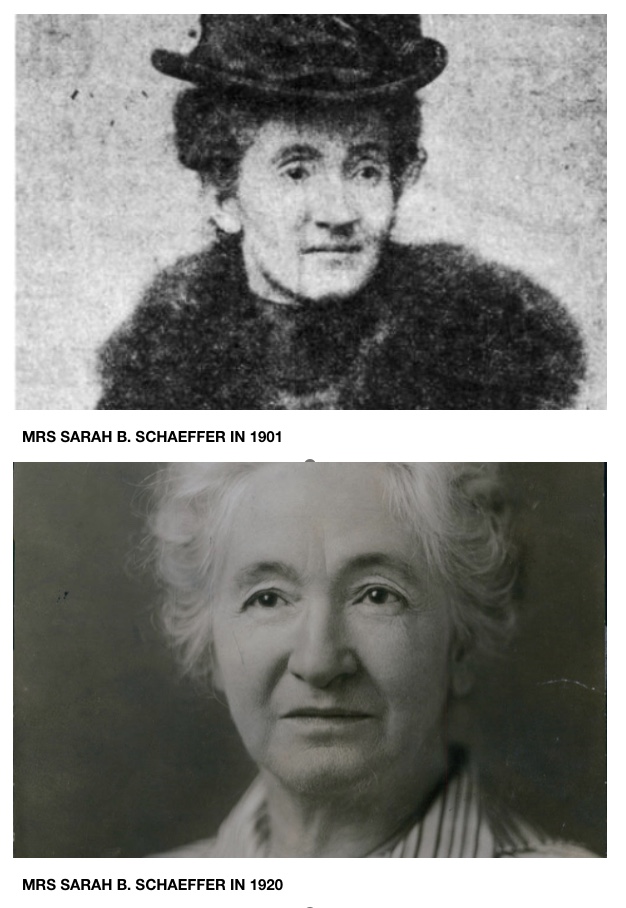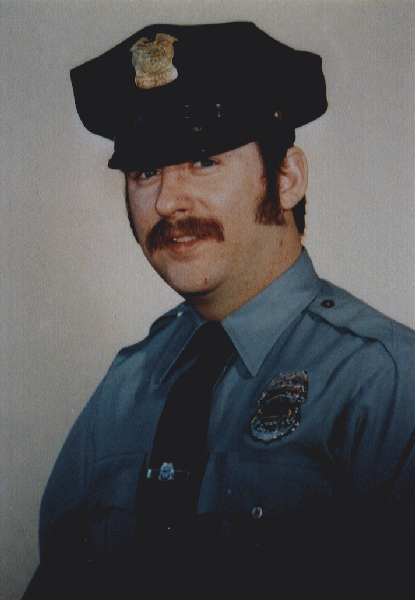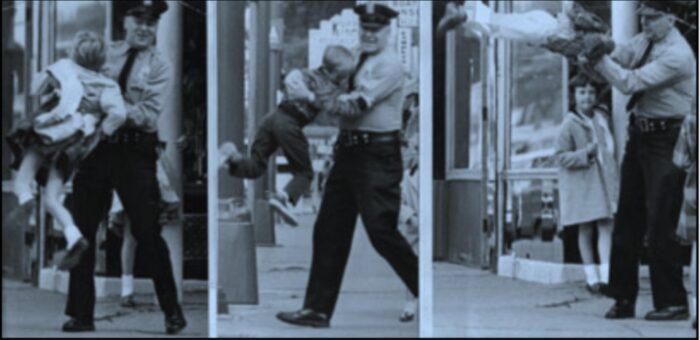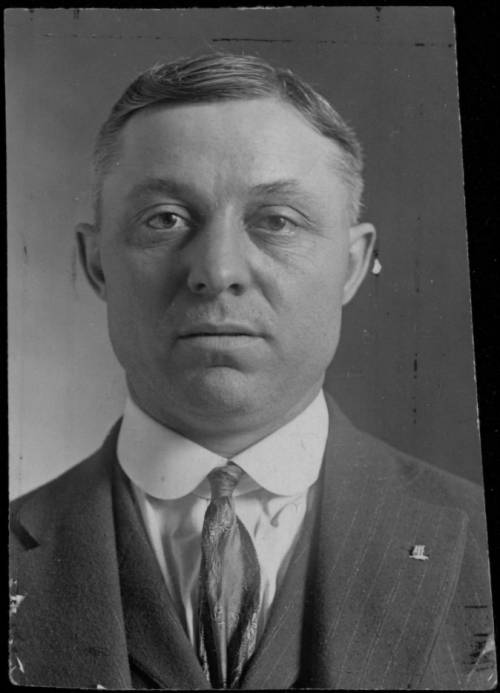Watch Episode Eight in the Minneapolis Police Museum video podcast series to learn more about Lieutenant Grant Snyder’s work in the MPD and with InvolveMN: https://mplspolicemuseum.org/podcasts/
Latest Posts
oh deer!
On a snowy March day in 1951, Minneapolis Traffic Police encountered an unusual traffic safety hazard.
A 100 pound deer bounded down Groveland Avenue for some time until it was finally safely captured at Chicago Avenue and 25th Street.
Officers Robert Byrnes, Frank Sacre, and Marvin Bentley posed with the deer before handing it over to the Game Warden for release outside of the Minneapolis.
On another occasion, in 1940, Minneapolis Park Police Officer W.R. James is shown checking on a deer that he had rescued from a group of boys at Minnehaha Park.
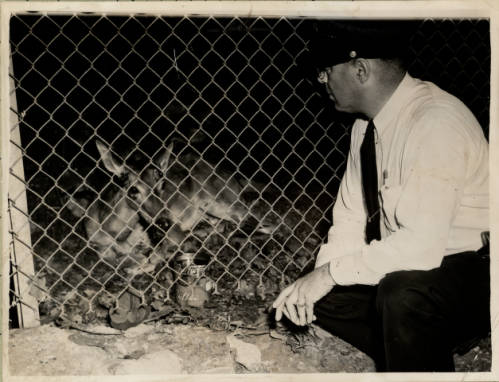
Top photograph from the Minneapolis Tribune of March 20, 1951
Bottom photograph courtesy of Hennepin County Library
three new galleries
We have added three new galleries to the website.
You can find them under the “MORE” section on the Home Page, or by clicking on the links below:
a contemporary view of the ging murder case
The 1894 murder of Catherine Ginn by Harry Hayward was the most notorious homicide case of Minneapolis’ Gilded Age.
Here is a recounting from the book “History of the Police and Fire Departments of the Twin Cities: Their Origin in Early Village Days and Progress to 1900” (published in 1899):




lock-up alley
From 1867 until it was razed in 1933, Lock-up Alley was a well-known Minneapolis location even appearing on city maps.
Lock-up Alley was located on Washington Avenue between Nicollet and Marquette Avenues.
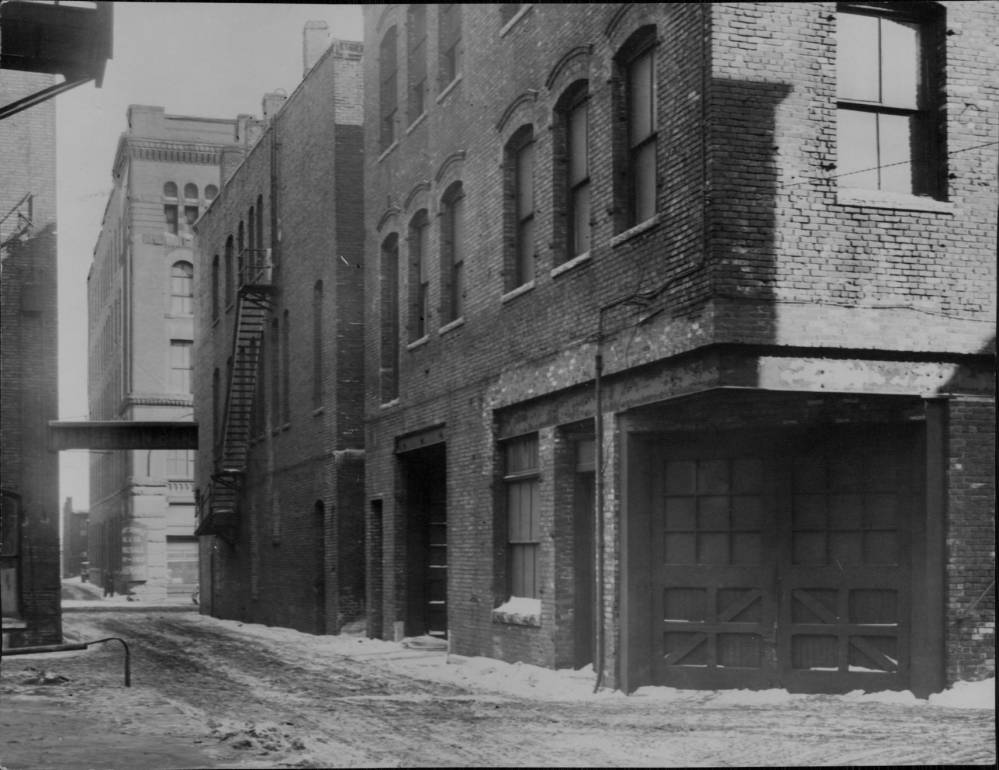

It was also the location of the Central Police Station, the Police Barns, and the jail.
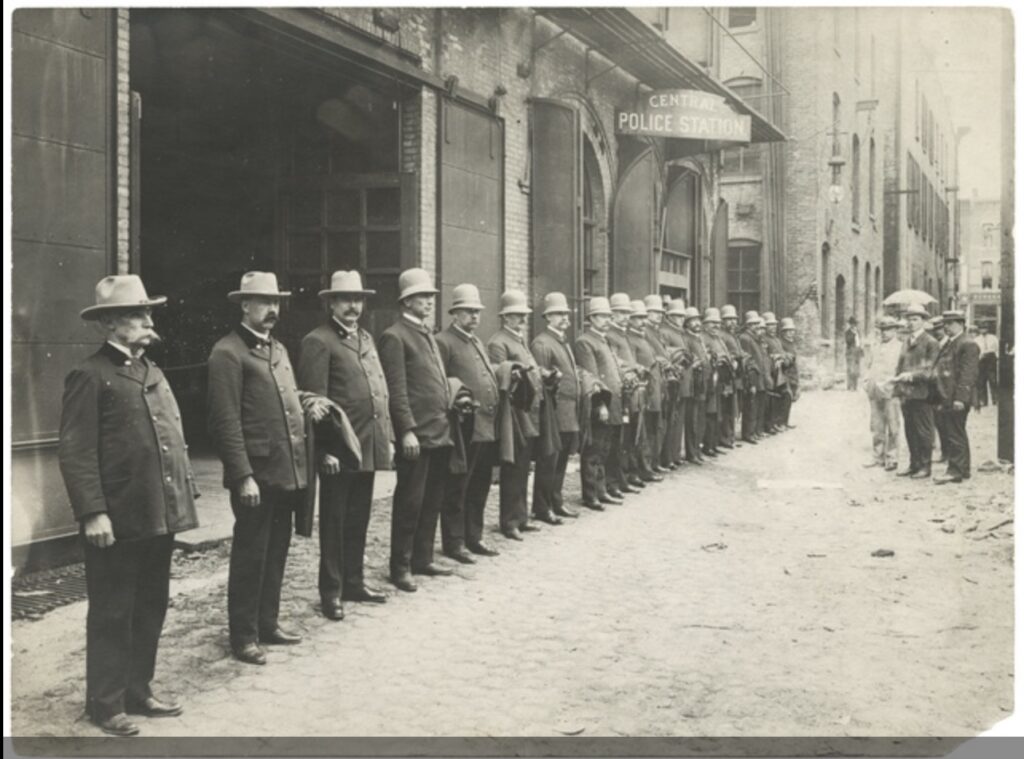
Despite its location near the Central Police Station, Lock-up Alley – like the nearby Fish and Jumbo Alleys – was a rough place. The Minneapolis StarTribune mentions Lock-Up Alley frequently and nearly always in conjunction with stories of fights, stabbings, runaway horses, public drunkenness, and fires. Additionally, because Lock-Up Alley was unpaved, it was a hazardous place to travel through. In fact, in September of 1903, Lock-Up Alley was for a time judged to be nearly impassable while under eight inches of watery mud.
The most famous resident of Lock-Up Alley was Minneapolis Police Matron Sara Schaeffer who lived in a suite of two rooms at the jail from 1901-1927.
The most infamous person to be jailed in Lock-Up Alley was Harry Hayward, the Svengali-like figure who was tried and convicted in the 1894 murder of Catherine “Kitty” Ginn.
officer william r. lundquist and the k9 unit
The late Retired Officer William R. Lundquist began his career in the Minneapolis Police Department as a member of the Rookie Class of 1966-1967.
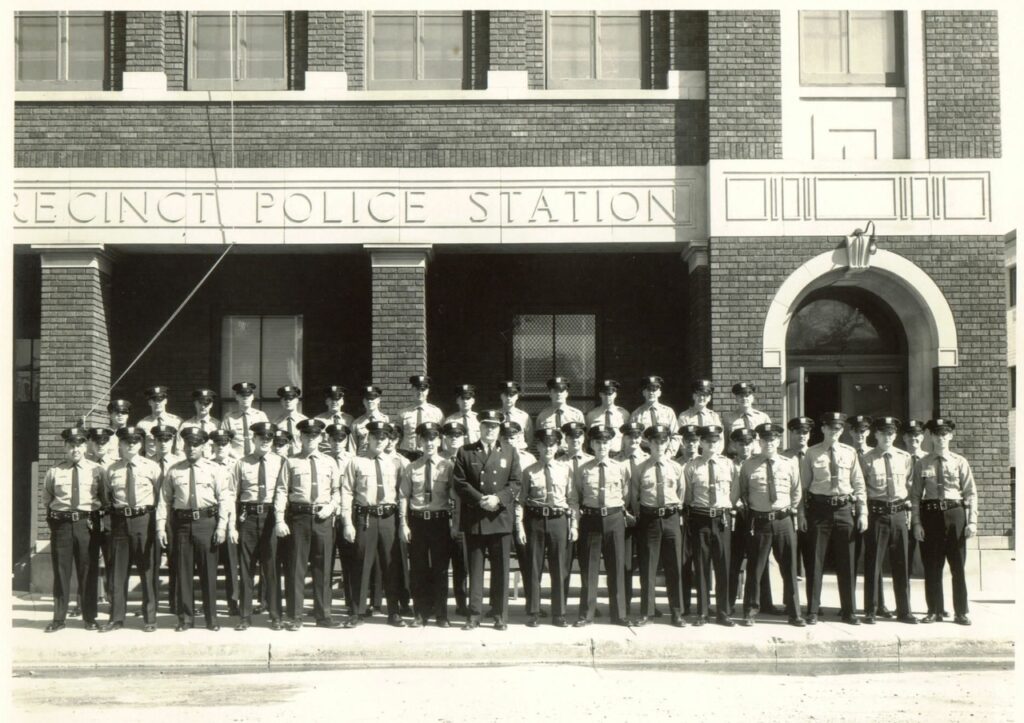
Officer Lundquist, along with his partner Sergeant, was a member of the original 1970 K9 Unit. The unit had eight teams. They were: Officer William Lundquist and K9 Sergeant; Officer Mark Jacobson and K9 Rommel; Officer Phil Bishman and K9 Lance; Officer Dave Neibur and K9 Thor; Officer Richard Stahura and K9 Trooper; Officer Dick Morrill and K9 Rex; Officer Roger Fancher and K9 Clancy; and Officer Charles Adams and K9 Lance.
Leveraging his experiences in the MPD, Officer Lundquist, along with Lieutenant Mike Fisher and Officer Al Hancock, helped the St. Paul Police Department to develop its own K9 Unit.
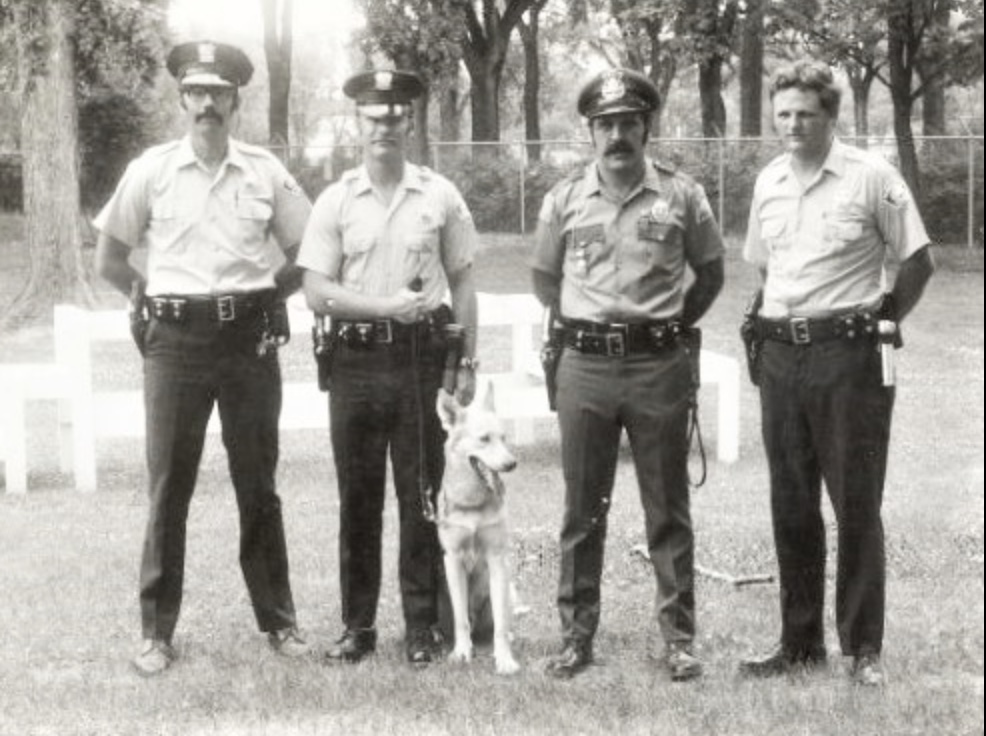
Officer Lundquist and his K9 partners were well known throughout the city and were a popular attraction at neighborhood events and at the Minnesota State Fair.

Officer Lundquist’s colleagues in the Minneapolis Police Department remember him as a great K9 officer and a good person who was devoted to his family.
Top photograph courtesy of Retired Officer Don Schwartz
more on minneapolis police matron sara B. Schaeffer
Mrs. Sara B. Schaeffer was born in Galena, Ohio in 1857 but spent most of her life in Minnesota.
She was the widow of Major Charles M. Schaeffer (died 1900) who served in the Spanish American War.
During the Spanish American War, Mrs. Schaeffer accompanied her husband to the battlefield where she was known as “The Mother of the Fourteenth Minnesota Volunteer Infantry” which was the infantry in which her husband commanded a battalion. She headed the emergency nursing station for the Fourteenth Minnesota and was much loved by the soldiers she cared for.
Upon the death of her husband, Mrs. Schaeffer became more deeply involved in church, civic, and women’s organizations where she made many friends. When she became interested in becoming Police Matron, her friends were concerned that she would not have the strength for the work so soon after her husband’s death. She was in a fragile state indeed but the work gave her purpose and as a result she was able to regain her health and sense of well-being.
Mrs. Schaeffer was appointed by Mayor A. A. Ames to the role of Minneapolis Police Matron in 1901 at the salary of $726 per year. She served at the City Jail, located on the top floor of the Minneapolis City Hall for 27 years under 11 different police chiefs. She lived in a two-room suite adjacent to the women’s cells for most of that time.
When Mrs. Schaeffer began her service, before the advent of policewomen and before the time of women patrol officers, the Police Matron was responsible for all interactions with women and juveniles from the time they were detained by officers until their release from the City Jail. She also had responsibility for lost and neglected children and abandoned wives.
After 1914, when the Minneapolis Police Department began to hire policewomen, Mrs. Schaeffer was relieved of some of her street responsibilities and was able focus her work on helping women and juveniles during during their time in the City Jail and during their court appearances. It is estimated that by the end of her career she had worked with approximately 100,000 women, boys, and girls.
When Mrs. Schaeffer joined the Minneapolis Police Department, women were taken from the jail to the court in an open wagon for all to see. Mrs. Schaeffer objected to this practice because of the damage it could do to the reputations of women who might subsequently be found to be innocent by the court. She worked with the Department and in quick time was able to change this practice and walk her prisoners to the court instead. Mrs. Schaeffer took pride that no prisoner whom she escorted ever attempted to escape. Her promptings to the Department further led to the purchase of a covered Black Maria for prisoner transport.
Mrs. Schaeffer was known by all as a kind and compassionate woman who was also no pushover. Like many Police Matrons of her day, she was optimistic about the ability of some criminals to reform and realistic about the terrible impact of their crimes upon their victims. If she felt that a woman could successfully re-enter society after her release, she followed up and helped her to find a job. The walls of Mrs. Schaeffer’s suite at the City Jail were covered with the wedding pictures of women she had helped and many of them visited her later to introduce their babies and celebrate other milestones in their lives.
Mrs Schaeffer retired from the Minneapolis Police Department during Mayor Leach’s term, in 1927. She was honored by him and by Police Superintendent Frank Brunskill along with a host of county and federal judges, districts attorney, civic and business leaders and various members of the Minneapolis Police Department at a banquet. On this occasion, Mayor Leach said to her “I want to thank you for the service you have rendered the community and humanity in general”. Detective Thomas P. Gleason recited a poem that he had written in her honor.
A fund of $8000 had been subscribed and invested for her and part of the money was used to purchase what Mrs Schaeffer referred to as her “cottage” where she intended to spend her time tending her flowers.
Sixteen years later, funeral services for Mrs. Schaeffer were held at her beloved home at 3223 Portland Avenue South. She was buried at Lakewood Cemetery on the afternoon of April 16, 1943 with family and friends in attendance.
Mrs. Schaeffer’s cherished home still stands today as the well-restored Bridgham House B&B.
RETIRED OFFICER ROBERT HUBER AND THE EARLY DAYS OF COMPUTERS IN THE MINNEAPOLIS POLICE DEPARTMENT
We were fortunate this week to visit with Retired Officer Robert Huber to learn about the MPD’s early computer systems and hear about an interesting computer-crime investigation of his which made headlines both in Minneapolis and nationally.
Office Huber was studying at what was then St. Thomas College (now University) in a pre-med program when friends of his persuaded him to join them at the Minneapolis Police Department. He had always been good at mathematics and so when the Department gave him the opportunity through the Law Enforcement Educational Program to go back to college he resumed his education part-time focusing on mathematics and computer languages.
Officer Huber was known around the Department as someone who understood computing. In 1979, the Deputy Chief in charge of Technology tapped Officer Huber to work on a new initiative called the Integrated Criminal Apprehension Program or ICAP. The idea behind ICAP was to use data about crime such as time of day, location, type of crime, perpetrator behaviors to quickly understand and address crime trends.
After this, Officer Huber went on to help develop a Computer-Aided Crime Analysis and Reporting System which gave the Department the distinction of being only the second police force in the nation to leverage computer systems for crime analysis. With the work of Officer Huber, the Department was able to replace its manual pin-map system with a digitized map system employing elements of predictive analysis.
Before November 31, 1982, if you had an emergency, you would open up your telephone book to find the number for the Minneapolis Police Department, The Minneapolis Fire Department or an ambulance and then call the appropriate seven-digit number for your particular emergency.
The Minneapolis Police Department was the first Department in the nation to make the move to a 911 system and Officer Huber worked on the integration of the 911 system with a computer-aided dispatch system.
Officer Huber was fortunate to be asked by the FBI to join its computer-crime course at their Academy in Quantico, Virginia. He brought his new knowledge back to the Department and used it to help solve computer-crimes.
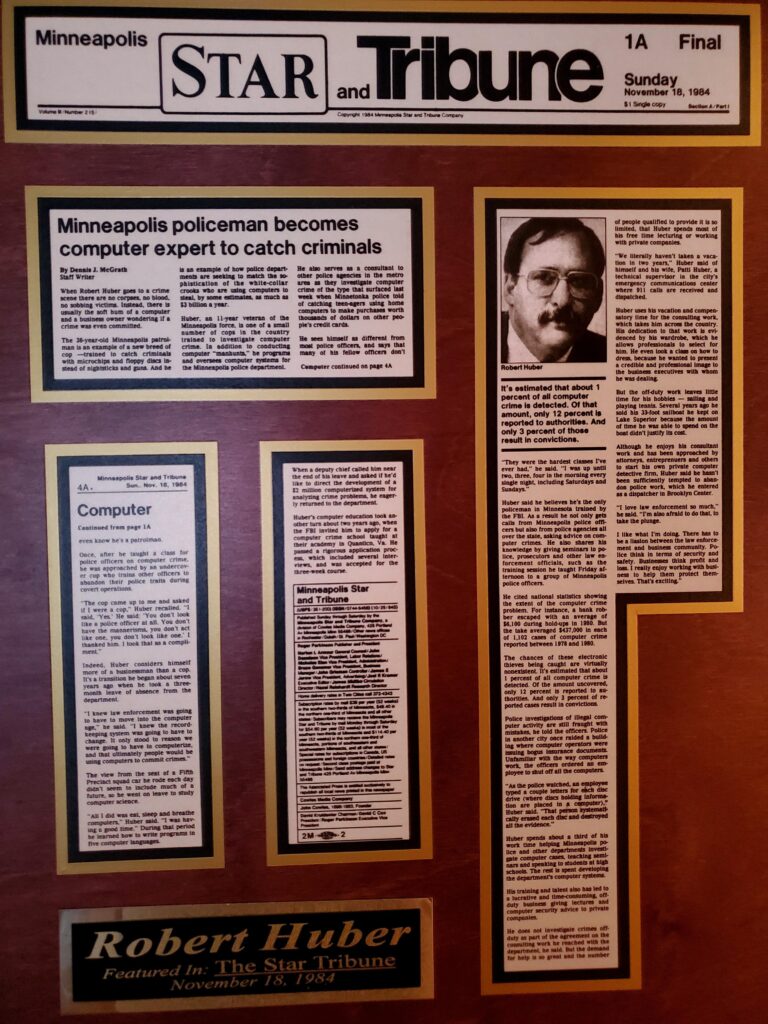
In 1985, Time Magazine told the story of an interesting computer-crime case that Officer Robert Huber worked on.
They wrote:
“Peggy Leppik will never forget the day in 1983 when she opened the door of her house in suburban Golden Valley, Minnesota and found three Minneapolis police detectives waiting outside. Someone with a home computer and modem had tapped into the computer of a Minneapolis bank by telephone and police had traced the calls to her 14-year-old son Peter. “My heart stopped,” she says. “But I was confident from the beginning that he hadn’t done anything malicious. I have lots of faith and trust in Peter.” No charges were filed against Leppik and his mother’s faith was dramatically rewarded last week when his latest exploits brought strangers of another sort to her door: reporters and camera crews eager to learn how the precocious lad, now 15, had become a hacker hero, helping the Minneapolis police in a case against a suspected child molester.
Last month a 37-year-old Minneapolis computer programmer was arrested on charges of sexual misconduct with a 13-year-old boy. In the man’s home, police found a Tandy RadioShack TRS 80 Model III computer and several dozen floppy disks, which they suspected might contain incriminating evidence. The suspect, however, had locked his disks with a special software program. Only someone who knew his six letter password, which he refused to reveal, could read the information they contained.
The police department’s resident computer expert Officer Robert Huber was not familiar with the RadioShack computer system, but knew someone who might be: Peter Leppik, whom he had met during the bank escapade and since befriended. “After all the unfavorable stories about computer kids”, says Huber, “it seems like an ideal time to have a younger person like Peter do something positive for the community”.
The police drove Leppik to a nearby RadioShack store, which had offered the use of one of its machines. It took him less than a half an hour to familiarize himself with the TRS 80 disk operating system, the master program that tells the computer how to store and retrieve data. Said Leppik, “I realized right away that there was no way I could get the password by trying to guess that so I had to find a way around it”. After loading the data from an operating system disk (used for housekeeping chores as making backup copies of valuable disks) into the computer he placed a disk belonging to the suspect in one of the machine’s disk drives and a blank disc in the other. He then called up the operating system’s menu which lists on the screen all of the commands the system responds to. One after another he typed the command into the computer. When he typed BACKUP the computer responded by asking for the unknown password. The same thing happened when he typed COPY.”
Finally Leppik tried CONVERT a program that RadioShack distributed in 1982 when it introduced a new version of its operating system. It converts files written under the old version to the format used by the new one. But as Leppik discovered, RadioShack had neglected to build into CONVERT the password protection feature. As a result, at the command CONVERT, the computer whirred obediently, picking up the data from the locked disk and transferring it in the new format to a blank disk. From there, Leppik was able to retrieve it and display it on the screen. Only 45 minutes had elapsed from the time he entered the store.
The content of the first suspect disk turned out to be a diary containing page after page of sex-related material that included male first names, general locations and descriptions of sex acts written in graphic detail. If the accounts on the disk prove to be fact, not fantasy, police will use them to bring additional charges against the suspect. Leppik meanwhile is trying to keep things in perspective and not get a swelled head. Says he, “I’m still doing the dishes and making my own bed.”
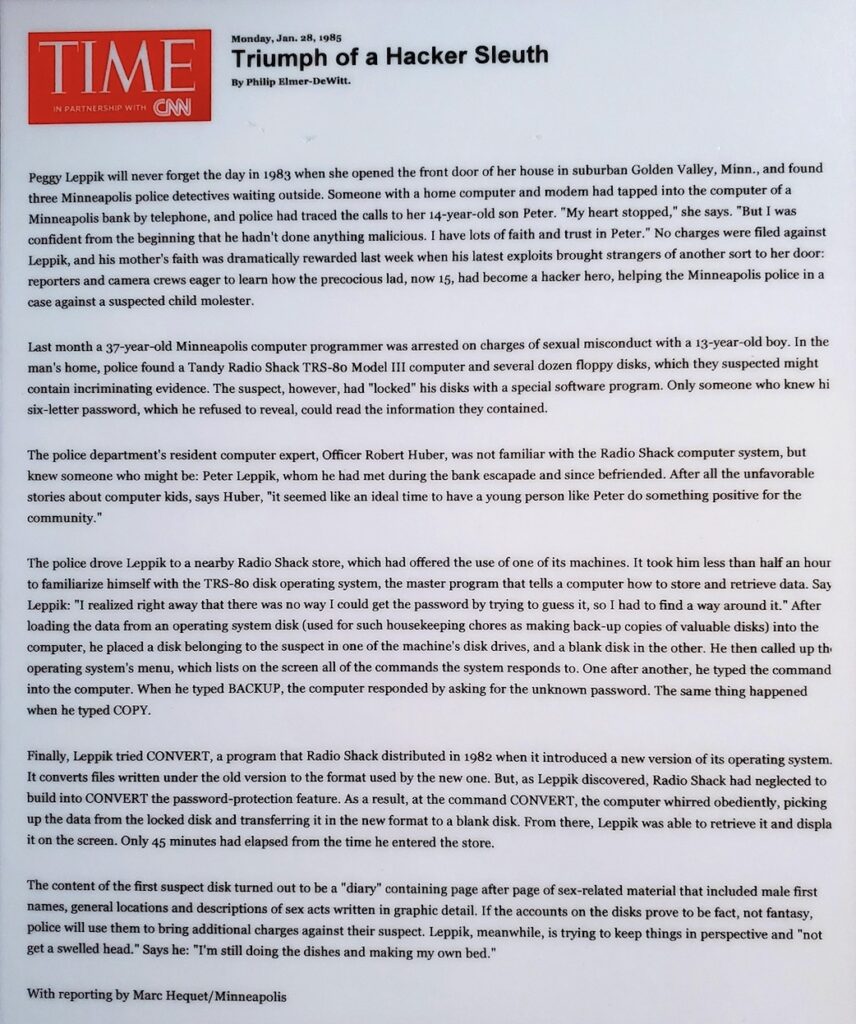
This story was also featured in US Magazine.
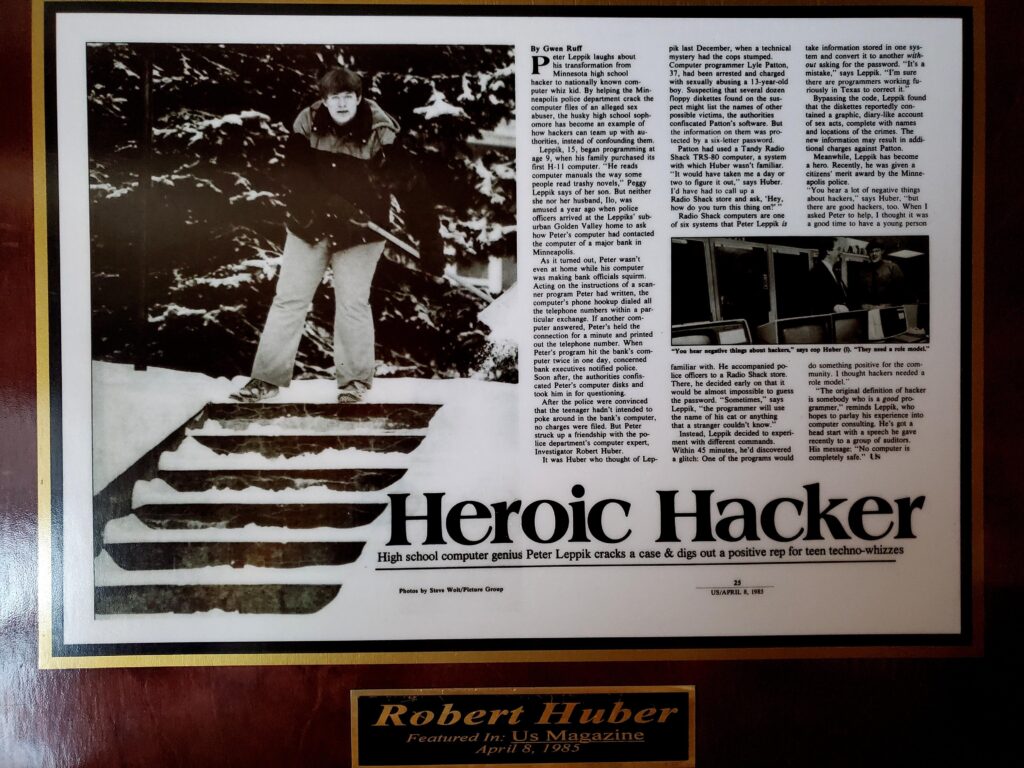
This was just one of the many interesting cases in the exciting career of Officer Robert Huber.

The Minneapolis Police Museum wishes to thank Retired Officer Robert Huber for the opportunity to interview him and for the use of the photographs in this story.
officer harold cronquist
You may recall this photograph of Officer Harold Cronquist helping with the school patrol from a previous post.
Officer Cronquist’s two daughters, Lynn and Gail, followed in his footsteps to become officers of the MPD.
Recently, Retired Officer Lynn Cronquist shared a previously-unseen photograph of her father in civilian clothes. It was taken between 1949 and 1950 when he was in Rookie School.
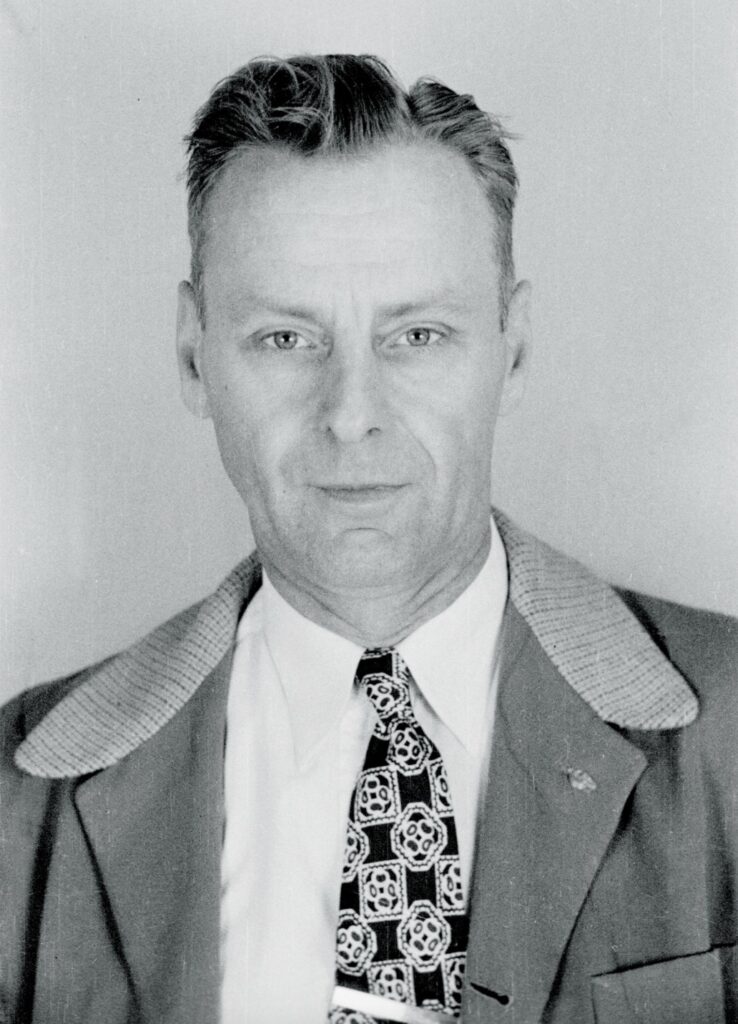
You will note that Officer Cronquist was a sharp-dresser!
Officer Harold Cronquist was well respected and well liked by colleagues and community members. When people who knew him speak of him today they remember him as a great officer and the kind of person they enjoyed being around.
Photograph of the late MPD Officer Harold Cronquist courtesy of his daughter Retired MPD Officer Lynn Cronquist
on this day in 1921
On this day in 1921, the Minneapolis Morning Tribune reported that Fred Rabinowsky, a box car robbery suspect arrested by Detective Joseph Berry (pictured above), was charged with grand larceny for the theft of five cases of shoes from a Great Northern Railroad freight car.
The man was taken in custody in the Gateway District and when searched was carrying a skeleton key, a file, and a private detective’s badge. He admitted the theft of the five cases of shoes to Detective Berry and led him to a place on the Mississippi River bank where the shoes were hidden.
When the hiding place was searched the discovery was made, according to the arrest report, that three of the five cases of shoes had already been stolen by a man in whom Rabinowsky had confided details of the robbery.
Photograph of Detective Joseph Berry taken in 1922 and shown courtesy of Hennepin County Library
